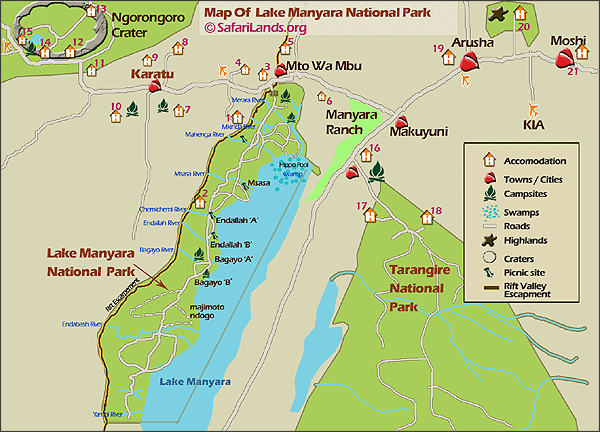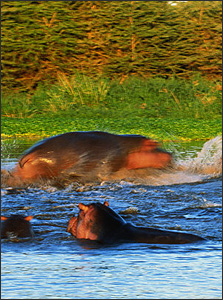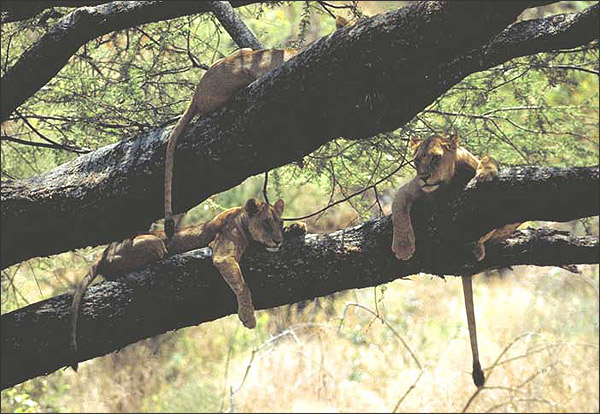| |
Join mailing list
Use Email to Register
|
|
Tanzania National Parks and Game Reserves - Lake Manyara National Park
Tanzania info >
Tanzania Parks and Reserves > Lake Manyara
National Park
Lake Manyara National Park,
which encompasses an area of 330 sq.km, of which 200 sq.km is lake,"extolled
by Ernest Hemingway as "the loveliest I had seen in Africa""
was proclaimed a game reserve in 1957 and registered three years later
as a National Park. The park is situated between the 600 m high escarpment
of the Great Rift Valley and Lake Manyara and is 130 km from Arusha.
Lake Manyara has 5 distinct zones: -. Ground water forest
with towering mahogany and fig tree; - Extensive marshland reeds; - Plains
of grassland; - Parklands scattered with acacia trees; - Scrubland on
the face of the rift wall

Lake Manyara National Park and Its sorroundings, click
the map to expand and view details
Thus, it can be visited on a day excursion from this centre. At the Southern
end of the park are hot Sulphur Springs known as Majimoto. Further along
the forest the area opens up into woodlands, grassland, swamps and beyond,
the soda lake itself.
Wildlife; Nestling at the base of the Great Rift Valley
escarpment, the park is recognized for its incredible beauty. Wildlife
at Lake Manyara is not restricted to birdlife only. Many game animals
such as Buffalo, Elephant, Giraffe, Impala, hippo and a great variety
of smaller animals also inhabit the park.
 Lake
Manyara is also renown for its tree-climbing lions which spend most of
the day spread out along the branches of acacia trees six to seven metres
above the ground. The park contains the most pachyderms per km sq. in
Tanzania. As visitors enter the gate, they pass into the lush forest,
home to troops of baboons and blue monkeys. Buffalo and hippo lurch in
the adjacent Hippo Pool. The vegetation eventually merges into flat topped
acacia woodland where, in the heat of the day entire prides of lion can
be seen stretched on the branches of these trees - a habit prevalent to
Manyara lions. Lake
Manyara is also renown for its tree-climbing lions which spend most of
the day spread out along the branches of acacia trees six to seven metres
above the ground. The park contains the most pachyderms per km sq. in
Tanzania. As visitors enter the gate, they pass into the lush forest,
home to troops of baboons and blue monkeys. Buffalo and hippo lurch in
the adjacent Hippo Pool. The vegetation eventually merges into flat topped
acacia woodland where, in the heat of the day entire prides of lion can
be seen stretched on the branches of these trees - a habit prevalent to
Manyara lions.
Along with these amazing tree-climbing lions there are the usual browsers
and grazers as well as the curios-looking banded mongoose. Two thirds
of the park is dominated by the slightly alkaline lake which is home to
a huge variety of waterbirds.
Birdlife; More than 400 species of bird including flamingo, pelican,
red billed quelea, storks, sacred ibis, cormorants and Egyptian geese
can be sighted in this area. Other species of birds include the African
spoonbill, lesser flamingo, white pelican and white faced duck.
Getting There: Lake Manyara National Park is 130 km west
of Arusha and the drive takes about two and half hours. The entrance to
the park is off to the left of the Great North Road at Makuyuni. From
here there is a track that goes past the lake and through the village
of Mto wa Mbu to the park entrance.
Dry season (July-October) for large mammals; wet season (November-June)
for bird watching, the waterfalls and canoeing.
Temperature
(Maximum Celsius in Resort Areas)
Area
J F M A M J J A S O N D
Manyara 28 29 29 26 25 23 21 19 23 26 26 28
|
Rainfall
chart.
Area
J F M A M J J A S O N D
Manyara 13 10 8 22 13 1 1 1 2 5 14 18
(To convert into inches, divide by 25.4)
Rainfall
Figures (All in mm)
|
Mto wa Mbu ( meaning Mosquito Creek) is a small busy market town selling
fruit and vegetables produced by the fruitful adjacent farms. The little
settlement has become a temporary stop over for tourists and campers.

When To Visit; The dry season of July to October is the
best time to visit to spot large mammals, whilst the wet season of November
to June is the best time for birdwatching.
|
|
